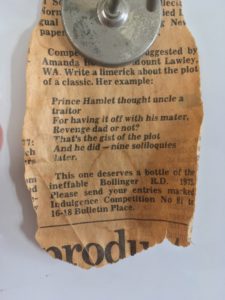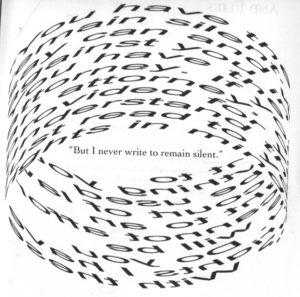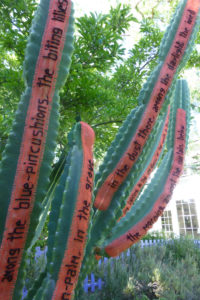On and Off the Page: atypical poetries (part 1)

It is not an unusual Friday when I find myself sitting in my apartment, a glass of wine in one hand and a collection of poetry in the other. I’ve also been known to sit on my kitchen floor and compose bad haikus from the Mixed Up Movie Lines magnetic poetry kit on my refrigerator. And sometimes towards the end of the night, I ponder, weak and weary, about the difference between Edgar Allen Poe’s “The Raven” and William Carlos Williams’s “This Is Just To Say,” or the Hamlet-inspired limerick on a newspaper cutting also adorning my fridge from at least two decades ago:

The question “what is poetry?” has been a topic of conversation and rhetoric—if not a heatedly debated subject—as far back as Western memory goes. Aristotle’s Poetics lists qualities of epic poetry: language, rhythm, subjects, methods, etc.
Methods, translated to a more contemporary vocabulary, might be form, something T.S. Eliot was certain was dead by the twentieth century. “In a formless age,” he writes in “The Possibility of a Poetic Drama” (1921), “there is very little hope for the minor poet to do anything worth doing.” Though doubtless one of the brilliant poetic minds of his time, Eliot also had the tendency to exude some pomposity.
In the twenty-first century, the fun (read: debate about form) continues. What should a poem look (or in the following case, sound) like?
One editor, in the Guardian, has argued that Marshall Mathers aka Eminem aka Slim Shady is a poet in his own right, comparing the rapper to Yeats, Browning, Whitman, and Chaucer, opining that he is a “rapper whose genius is, principally, poetic.” He cites poetic tropes such as various speakers, and locates them within the rapper’s oeuvre. Mathers’s various pseudonyms alone are enough to convince us that there are several personae’s voices within his work. As most readers of poetry know, the voice of the speaker may not necessarily be representative of the voice or sentiments of the poet, something Mathers has insisted upon both publicly and in his work. (From “Stan,” in response to a fictional letter writer to Mathers: “I say that shit just clownin’.”)
Though this is an interesting argument, and one that I am sure many listeners would agree with, I think we can pretty confidently conclude that Eliot—and perhaps some editors of major poetry publications—would not agree. Hence, the ongoing debate.
However, there are many poets who push the traditional formal boundaries of words on page that aren’t found on KIIS FM’s American Top Forty. Two such poets are the 2017 Kate Tufts Award winner, Phillip B. Williams, and our very own Genevieve Kaplan (who I am fortunate enough to share an office with), winner of the 2009 A Room of Her Own Foundation’s poetry publication prize.
Williams’s Thief in the Interior, alongside traditional form, features several poems that experiment with shapes. One of the most striking of these atypical forms is in a series of six circular sections, titled “Inheritance: Anthem.” The words in the center of some circles overlay one another and in others, the inner part of the poem looks perfectly traditional. The outer rims of the circles, contrastingly, appear as if the words have been overextended in the WordArt function of Microsoft word (which they very well may have been), but unlike playing with WordArt, this is not a flippant or playful choice.
Rather than the usual association of circles (completion, wholeness, eternal love [Cf. wedding rings]) they function as a method of fierce critique on the state of racial violence in America. “I wanted to . . . imprison [the poem] in the very language that is meant to be reflective of how justice works in the United States,” he told me.
He addresses the way in which the language that portends to keep citizens safe is in fact a byway to further impunity inflicted on American—specifically black—citizens. When the response to this breach of trust results in peaceful protests that are subsequently judged to be “un-American” the tables flip, and what represents American values is now a blatant and deeply disturbing disregard for black lives and real justice. He decided on the shape of the poem during the Michael Brown protests, during which one of his friends, kneeling, was punched in the stomach by a police officer before being taken away.
The first five sections of the poem have text that is difficult, if not impossible, to read. The text that forms the circles becomes slightly more legible through each section, ultimately revealing itself to be the Miranda rights. Of the last section, Williams wrote to me,
“I had to be sure that the most known part of the Miranda Rights, ‘You have the right to remain silent,’ was indeed legible and therefore made what was illegible known. This, for me, comments on the illegibility of the law, how what is most familiar can become so strange and violent and meaningless.”

Similarly jarring, another poem in the collection, “Inheritance: Spinning Noose Clears Its Throat,” is in the shape of a noose. He describes some of his intentions for this poem in an interview with CGU, wherein he discusses the responsibility that the noose shape elicits. In turning the page, he tells us, we are forced to abandon the noose, as if we are leaving it behind, unconcerned. This feeling is unsettling. In bypassing a vehicle for murder, readers are at the very least troubled, and at the most disgusted with the necessity of ambivalence to continue reading. But the best protests—the best resistances against tyranny and injustice—upset us on a visceral level. Williams’s poems are amplified in their power to do this through their unconventional form.
***
Kaplan’s work approaches dismantling traditional poetry spaces in an entirely different way; in some of her work, she removes poetry from the page. Currently, Kaplan is working on a project of woven broadsides; that is, poetry stitched or woven on ribbons.
One of Kaplan’s aims with this kind of poetry is to recreate the unseen labor that goes into the process of writing poetry, and to show the difficulty of writing in a definable way. Any good writer will tell you that editing is a major part of the creative process (and editors will tell you that it is the most important). Either way, the reader never sees it.
These poems beckon the reader to participate in the moment of creation. In examining the individual stitches, imperfections, and the poems’ visible complexity, the reader’s work is complicated in that they also become a viewer. Kaplan’s own process also forces a more in-depth contemplation of the words. Each line’s creation is lengthened into the better part of an hour rather than the few seconds a keyboard stroke requires. “I become closer to the poem,” she said. “I discover new meanings I hadn’t yet contemplated.”
But while emphasizing the difficulty of creating poetry, she simultaneously charges her form with the responsibility of making poetry more accessible.
A far-too-common view of poetry pressures us to believe that the only way to read poetry is to discover its secret meaning. This assumption has the effect of shunning the average Joe, not the least likely because poetry makes Joe feel stupid. It is no wonder then, that Everyman isn’t clamoring for a copy of the Paris Review.
But Kaplan’s off-the-page work glides seamlessly past these barriers. In a recent exhibition, her poetry adorned cacti in a garden.

“The first thing you think,” she said, “when you see these poems isn’t ‘I have to figure out what this means.’ It’s just ‘I have to look at it.’” Her work is a visual invitation that inspires a curiosity and eagerness to read from a broad audience.
“They are visual first and poem second,” she said. “Which attracts other—or at least different—readers.” Case in point, she told me how an air-conditioning inspector got excited when he saw one of her works in progress.
In a time when public funding for the arts is at risk, it is more important than ever to make art inclusive and available; and unlike other public goods, poetry is not subject to the tragedy of the commons. One way to do this, as Kaplan does, is to put poetry where it doesn’t “belong,” outside of the confines of the ever-looming ivory tower of Poundian exclusivity. I am reminded of a shirt that reads “poetry is not a luxury,” a quote from Audre Lorde, that 2016 Kingsley Tufts Poetry Award-winner Ross Gay sports in a photo. Poetry is a necessity. It belongs to, and needs to be available, to all.
—Emily Schuck
Share